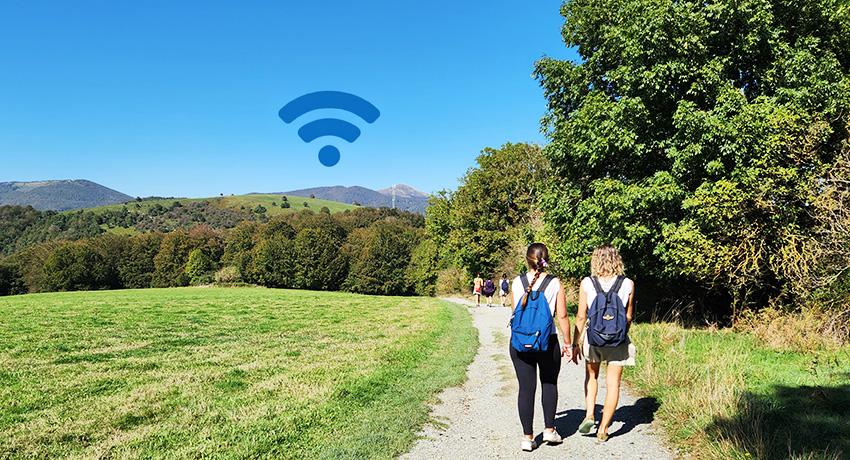Will my phone work?
Many travelers ask about using their American phones while walking the Camino de Santiago. There are two components to using your phone abroad: (a) Making phone calls, (b) Using your data plan for internet access, emails, messaging and social media.
It’s well known that U.S. telecom providers charge high fees for overseas usage, which may lead to a surprise on your bill when you get home.
There are two options to help you stay connected on your phone while keeping your costs under control:
1. Add an International Phone Plan
The simplest way to stay connected is to contact your cellphone carrier and see if they offer an international plan. Most carriers allow you to add this feature for a month and then switch back to your regular plan once you're back home.
An international plan from your US provider should cover both your phone calls and data usage abroad.
Make sure to call at least a month before you leave and confirm that your normal plan is reinstated when you return. This is the best option if you need to receive calls on your current US phone number while abroad, but it is usually the more expensive choice.
Most modern phones in the US (including iPhone, Samsung & Google) use the GSM standard and therefore will work in Europe. If you are using an older phone, you should double check that it uses the GSM standard (SIM card) so that your phone will work in Europe. If you call your carrier to ask about an international plan, they should be able to confirm that for you.
2. Get an eSIM for Spain or Portugal
A more cost-effective solution is to purchase an electronic SIM (eSIM) for Spain or Portugal. This option allows you to get a local phone number for calls and typically around 10GB of data for about 15 euros—plenty for most Camino needs, especially if you also rely on WiFi at the hotels. There are also providers that offer unlimited data options with pricing based on the number of days you plan to be in Europe.
Search online for an international eSIM provider to buy it before you depart, or acquire your eSIM upon arrival at the airport in Europe.
An eSIM can be activated digitally without needing to obtain a physical SIM card for your phone, making it a convenient option.
Before considering this option, you’ll need to:
- Check Your Phone's Compatibility: Your phone must support eSIM technology and the European GSM network. Most newer phones are eSIM-compatible and work on GSM networks, but you can check your provider's website or your phone's settings to be sure.
- Ensure Your Phone is Unlocked: If your phone is locked, it can’t use an eSIM from another provider. Phones bought directly from carriers like AT&T or Verizon may be locked. Verizon, for example, unlocks phones 60 days after purchase. Check with your carrier to see if your phone is unlocked or if they can unlock it for you.
Making Phone Calls abroad
Note that in order to make phone calls, you will need to dial any necessary prefixes to call internationally. For your reference, the country codes for Spain and Portugal are +34 and +351. The country code for the US is +1.
Making phone calls will be different depending on whether you are using your international plan from the US, or you bought an eSIM in Europe.
For example, if you have a US international plan (option 1 above) and want to dial a number in Spain (let's say, to reach your hotel), you will have to add a +34 in front of your hotel's phone number. Whenever you want to call the US, you dial the phone number without any prefixes.
Conversely, if you are using a Spanish SIM (option 2 above) you will dial the +1 prefix when you want to call the US. You will not dial any prefixes when you want to call your hotel in Spain, you just dial the number.
In general, International calls are expensive so we don't recommend using your cellular service to make international calls. The best way to save on calling costs is to use the call functionality that comes with messaging applications such as Whatsapp as discussed in the next section.
Messaging Without Extra Fees
Whether you use an international plan or an eSIM, avoid using SMS for texting, as it can be expensive.
Instead, download an app like WhatsApp to send messages, photos, and videos using your data plan —this is the standard in Europe and avoids SMS charges.
As mentioned above, Whatsapp allows you to make voice calls to other whatsapp users from inside the app. This app uses your data plan, which helps you keep costs under control.
Coverage on the Camino
While there is WiFi available in most hotels, most villages and accommodations are small and located in rural areas, so you should not expect high-speed access at all times. We recommend getting a cellular plan as discussed above, so you don't have to rely on WiFi.
As far as cellular coverage goes, it is generally available but keep in mind that this is a pilgrimage through rural areas, so there will be stretches of the Camino with limited cellular coverage.
If you’re looking to truly disconnect, consider putting your phone in airplane mode, using it only for photos, and connecting to WiFi at your accommodations. The Camino is a wonderful opportunity to take a break from constant connectivity and immerse yourself fully in the experience—your emails and notifications can wait!
Buen Camino!

